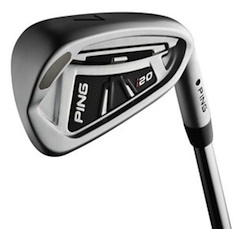 PING’s successful line of G-series irons has focused on maximum forgiveness for all players, but it’s i-series has been geared specifically to players who are looking for a middle ground between the G-series and the blade-like S-series. The i20 irons attempts to satisfy that audience by utilizing a series of designs that make the long irons forgiving and high-launching while blending in more-penetrating mid and short irons offering control for precise shot making. PGA Tour player Mark Wilson won the 2012 Bob Hope Humana Classic the first week he had the new PING i20 irons in the bag. Not a bad introduction for PING’s latest i-series offering. The i20 is for players as good as Mark Wilson all the way to your average mid-handicapper. Following in the tradition of previous models the i20 is a cast golf club with a progressive set design that delivers for a lot of forgiveness with a ton of playability.
PING’s successful line of G-series irons has focused on maximum forgiveness for all players, but it’s i-series has been geared specifically to players who are looking for a middle ground between the G-series and the blade-like S-series. The i20 irons attempts to satisfy that audience by utilizing a series of designs that make the long irons forgiving and high-launching while blending in more-penetrating mid and short irons offering control for precise shot making. PGA Tour player Mark Wilson won the 2012 Bob Hope Humana Classic the first week he had the new PING i20 irons in the bag. Not a bad introduction for PING’s latest i-series offering. The i20 is for players as good as Mark Wilson all the way to your average mid-handicapper. Following in the tradition of previous models the i20 is a cast golf club with a progressive set design that delivers for a lot of forgiveness with a ton of playability.
It was great for The Sand Trap to meet up with PING Senior Design Engineer Marty Jertson to learn more about these irons at the PGA Show in Orlando this year. Marty not only knows how to design great performing clubs but he can also play himself, qualifying for the Justin Timberlake PGA Tour event twice and qualifying for last year’s PGA Championship. The Sand Trap was able to get some of the finer technology details from that most golfers don’t know about.
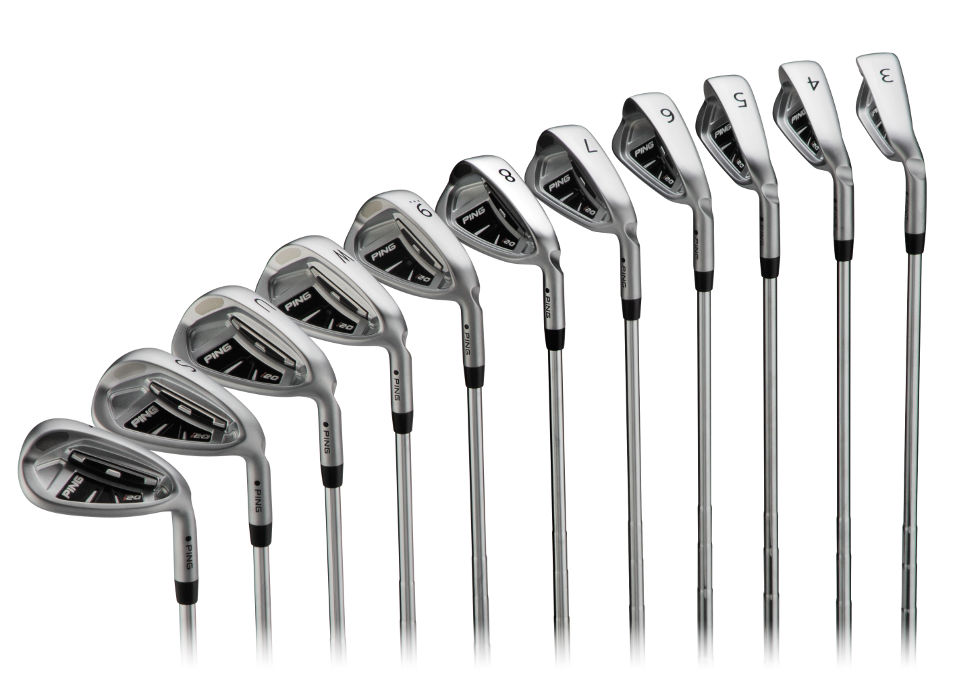
Technology
The i20 irons pack in a lot of new design tweaks from previous i-series models. The biggest visual change from previous i-series irons is the “toaster” style tuning port in the cavity. Previous models used an elliptical PING logo-ed badge in the cavity. The vertical Custom Tuning Port (CTP) and stabilization bars in the cavity are also featured in the PING S56 irons. The stabilization bars help improve feel along with a thicker face in the impact area, while the vertical CTP construction allows for a lower center of gravity, different options for weight positioning and swing weight custom fitting. This CTP allows PING to customize the swing weight for players that use longer, shorter, lighter or heavier shafts. The weights vary from 3-28 grams. This means that one golfer’s specs could be 3/4″ over length with S300 steel shafts and another could be 1/4″ shorter with graphite shafts but still use irons and wedges with the same swing weight.
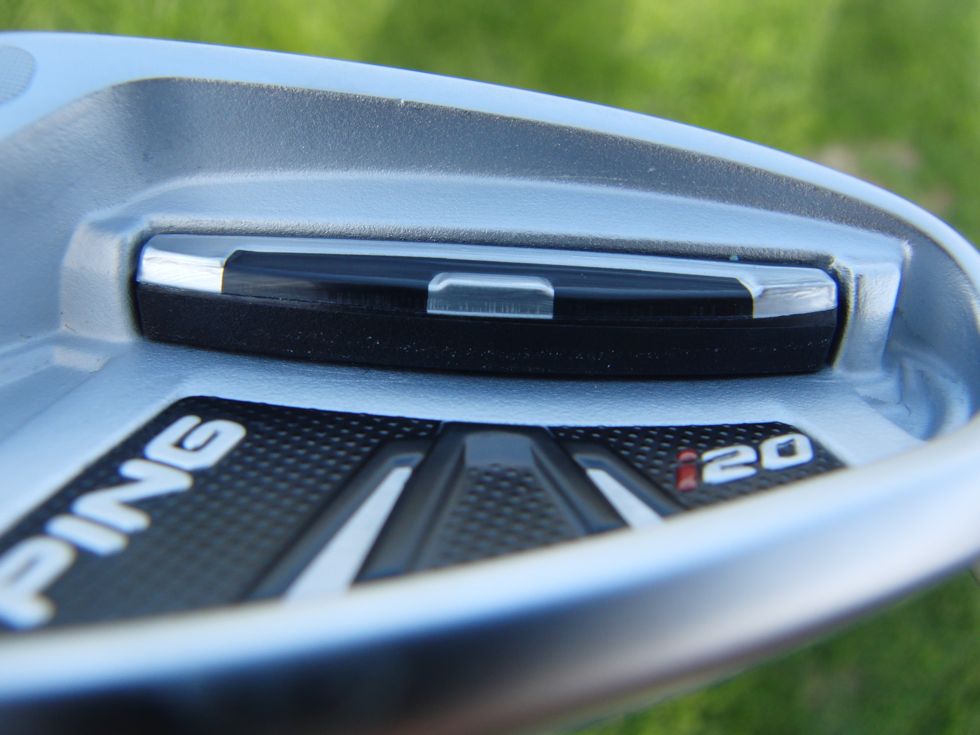
PING’s unique “toaster” style tuning port.
A new key feature of the i20s is the cavity structure design that manipulates the CoG (center of gravity) locations. In the long irons the cavity is cut more perpendicular to the ground, progressively pulling the CoG back to elevate ball flight in the long irons. For shorter irons the cavity is cut closer to perpendicular to the face which moves the CoG down and towards the front to give players more options with trajectory. Shorter irons can be flighted lower for optimal distance control. This pull cavity feature makes the clubs more user friendly while maintaining workable distance control throughout the set, prioritizing accuracy in the short irons and forgiveness in the long irons.
Taking a page from Karsten’s playbook, PING continues the use of high toe weighting, visible by the distinct toe geometry. This is similar to the design of the PING Eye2 irons, putting weight in the higher toe which drives up MOI (moment of inertia) because the center of gravity is in the center of the face. To add even more inertia there is a tungsten weight inserted in the low toe for added forgiveness and consistency.
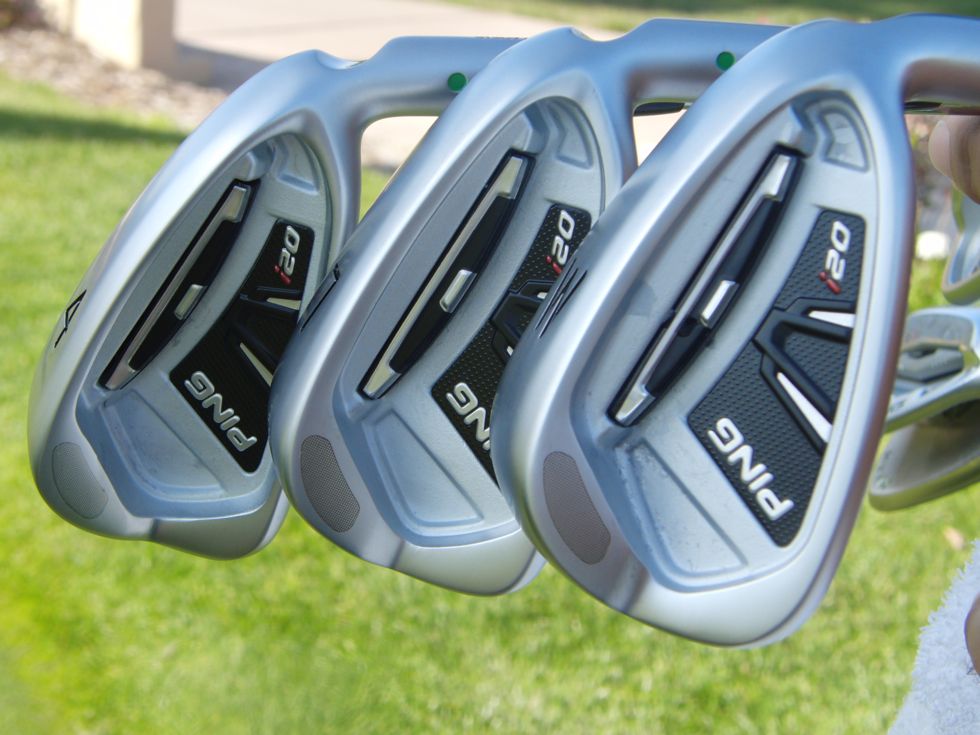
Another new feature is the sole design. We all know, or are learning, that bounce is your friend in wedges but it can also be beneficial in your irons. There is another golf company out there that is experimenting with 10° and more of bounce in the short irons. PING hasn’t gone that far but has adjusted the sole design to enhance turf interaction. According to Marty and PING, the i20s have a couple more degrees of bounce with the addition of a little smaller camber radius from the front to back. This makes it more rounded from front to back, it also helps the playability of the leading edge. With the i20s lower the center of gravity, the clubhead wants to deflect down into the ground when impacting the ball, so these design changes allow the club to glide through the ground, taking nice shallow divots.

Camber radius and bounce was added to the soles of the i20 irons
Esthetics
If you’re a fan of previous i-series irons, you’ll love the i20s. Absent is the industrial grey Guyson finish which is replaced by a non-glare satin chrome finish. This change makes the i20s look cleaner and like every line and curve was perfectly milled. There is also the addition of a black ferrule, first for the i-series, but well known in the PING S-series and PING tour wedges. The ferrules gives it a much less traditional “PING” look and provides a nice flow from clubhead to shaft. The black and silver color scheme adds to the player’s appeal and fits in well with the satin chrome. Less “decoration” in the cavity than the i15, more of a high performance look with the black tuning port and stabilization bars. It lets you see all the technology without being too much of a distraction.
As was the case with the i15’s, the i20s are noticeably longer heel to toe in the long irons, gradually decreasing in size to the short irons and wedges. This time around, PING made the top rail thicker in the long irons transitioning towards a thinner top line in the 7-W, dramatically increasing the MOI where golfers need it most.
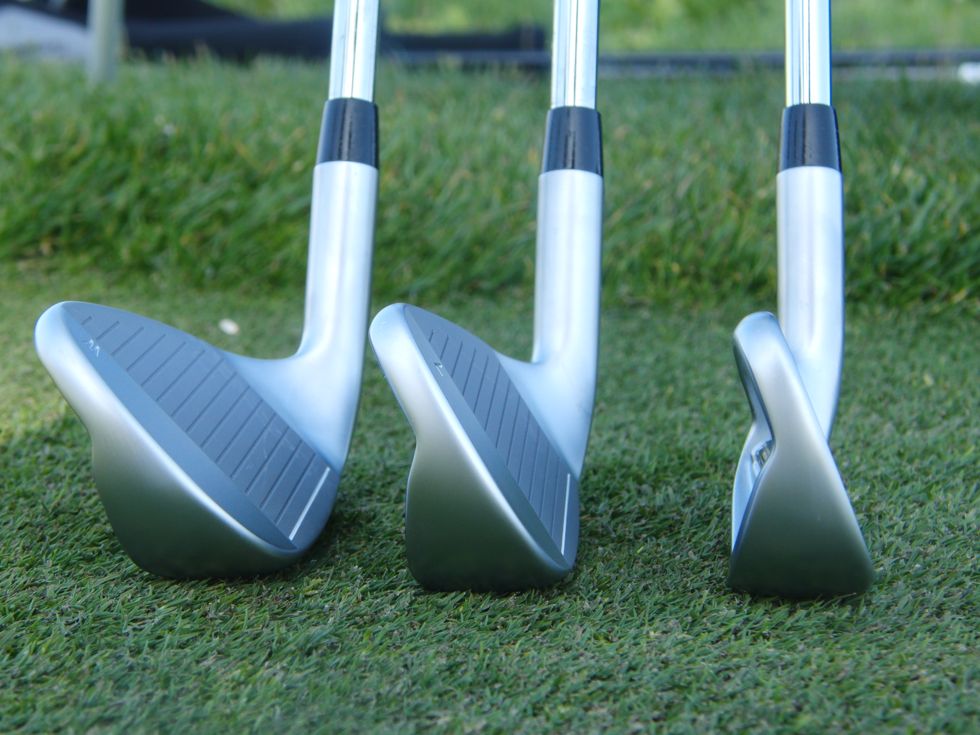
If you’ve gotten a chance to see the PING Anser irons, the i20s are very similar at address, as well with the toe to heel spacing. Some say it’s a blend of the i15’s and S56’s but I disagree, I would say it’s closer to a blend of the i5’s and S56’s. The blade length is a little longer from toe to heel than the i15’s, closer to the i5’s but with the satin chrome and style of the S56’s.
Compared to the previous i15’s, the i20s have less offset: .10″ in the i20s compared to .14″ in the i15’s. I find I like this look better, less distractions and makes it easier to line shots up. Obviously more offset than some “tour” irons out there but for a forgiving cavity back, the 6 iron-W in the i20s look great.
I personally don’t like thin top lines, like to see some “meat” behind the ball. As with the offset, the i20s are in between a game improvement club’s “chunkiness” and muscle back skinny. Yes there are some muscle back blades that have a thicker top line but in the general sense, if you like thin top lines, the i20 isn’t for you, unless you choose to get a custom grind from PING WRX (which I will get more into soon).
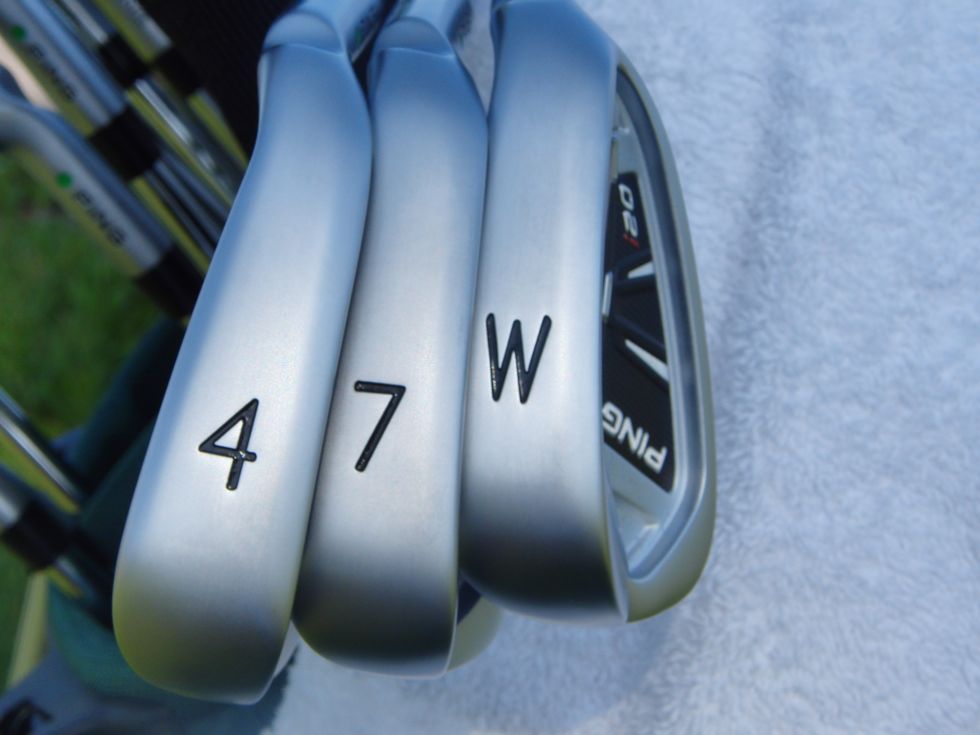
With each generation of i-series of irons, there has been a steady tweaking or you could even say departure from Karsten’s EYE2 irons. Karsten was more about the function of the club than trying to make a club look appealing at address. Now we’re getting a nice blend of both, much cleaner, softer lines with a ton of design features to help on off center hits.
As with most PING irons, the i20 has a number stamped on the high toe that let’s you know at address that you have the right club, and the bottom groove is filled with white paint to aid in alignment.
Playability and Feel
I’ve been testing the i20s in 4-UW (U is a gap wedge), green color code with the CFS (Control, Feel, Stability) stiff shafts. After talking with design engineer Marty Jertson at the PGA show he talked me into trying the new PING CFS shafts. For those new to this shaft, it’s based on the ZZ65, but has been expanded from the original hard stiff flex. One of the characteristics that made the ZZ65 unique was the thicker tip section, which reduced tip action at impact and flutter immediately after. In the S flex CFS, PING extended the tip by an inch to bring the stiffness to the current industry standard. Short irons get slightly less tip reinforcement to help with feel. In my previous irons I had the KBS Tour’s in stiff. They are a little lighter than DG s300’s, higher ball flight and slightly less spin. At about 110 grams, the CFS are the lightest shaft I’ve played with and was skeptical that I would like them. Since I could still have my clubs made with a D3 swing weight I haven’t noticed that much of a difference in overall weight.
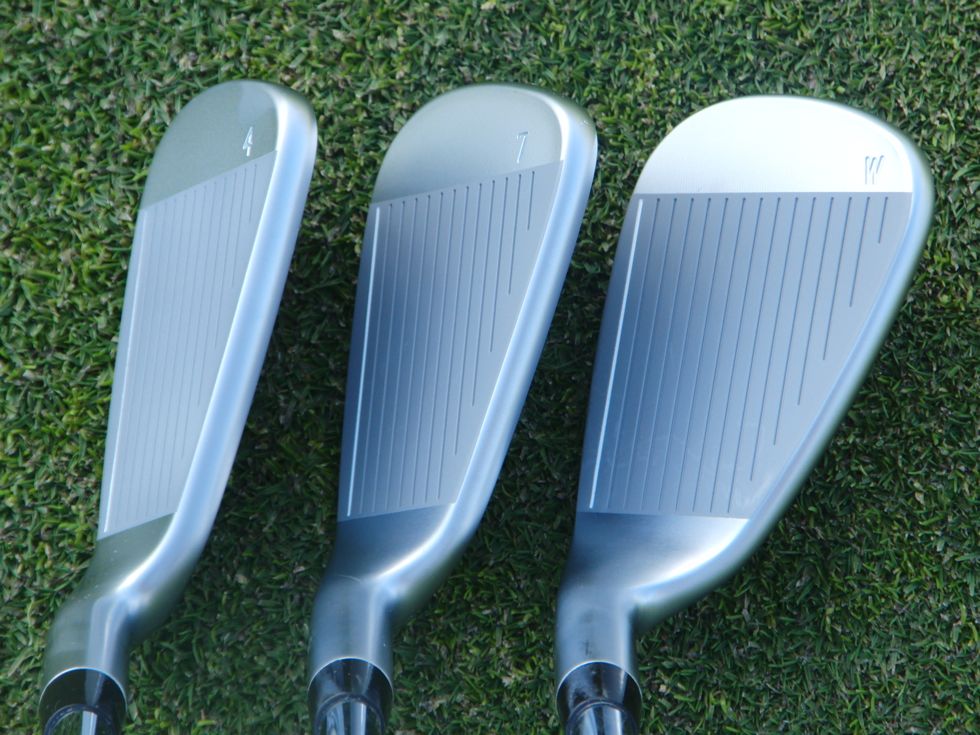
Specifying swing-weight is something that is available with no up-charge. There is a department of PING called PING Wrx that allows you to customize your clubs in a variety of ways. Custom grinds, custom paint fill jobs like Bubba Watson pink S59 irons or Chris DiMarco’s U of Florida blue and orange S56’s. There is an up-charge due to the extra time and work but it is available.
I played the PING i15’s for a year and a half and I was looking forward to getting a chance to play with the i20s. Right away I noticed the difference with the added bounce. Much more versatility and forgiveness from thin or thick lies because of the new sole design. Ball flight is a little higher than the i15’s and I’m carrying the ball further. Taking a look at the i15 bounce, I saw the 7 iron had 5° of bounce where the i20 has 8°. Not a huge change but I like the way they’re going, especially for a club that is moderately game improvement. My home course has very lush rough and thanks to the additional bounce, I haven’t had any trouble hitting solid shots that travel the correct distance from the second cut. Balls that are deeper in the rough come out higher than I’ve expected, which has been a nice surprise.
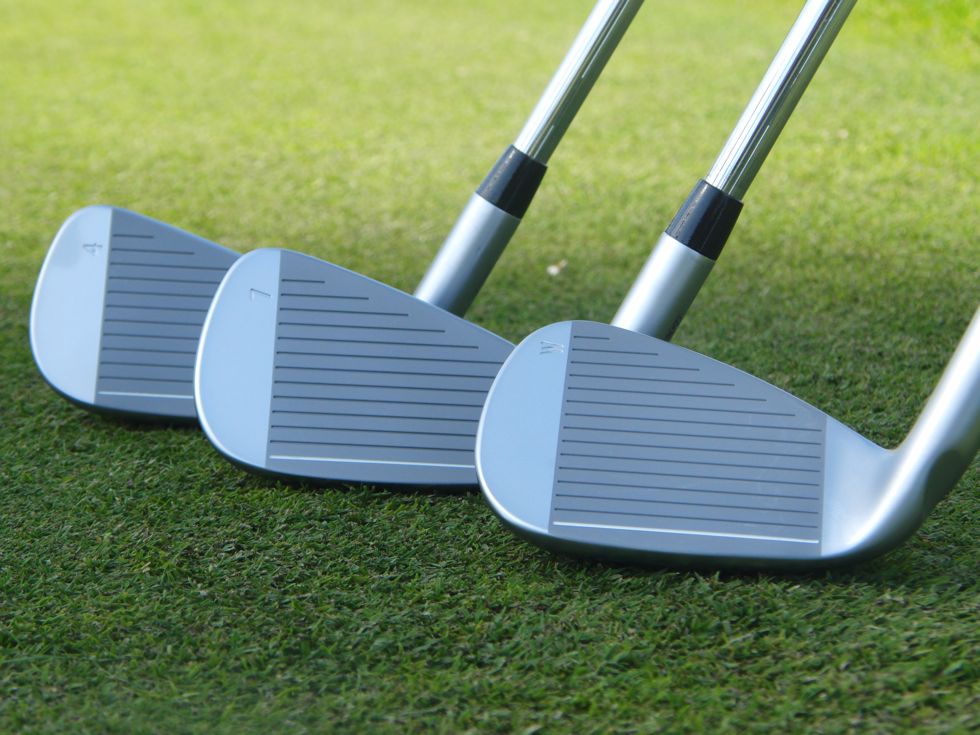
The best test has been playing some tournament rounds and I like how easy it is to control trajectory and distance. My miss tends to be thin, but the extra help I get from the CoG locations still gets the ball to launch high enough to carry a decent distance. Well stuck shots come off the face fast and land on the green soft. I did some testing on a Foresight monitor and saw that for 10 decent shots, I carried a 7 irons an average of 165 yards. Slightly longer than my usual and always fun to pick up a couple extra yards. I would also say the i20s launch the ball higher throughout the bag. Like the distance gain, it’s a small change but I’ve noticed on some of my better shots the soar into the sky with ease. Hitting the ball high is an advantage, sometimes I see members on The Sand Trap complaining about hitting it too high. While spinning the ball too much would be an issue, launching the ball in the air is going to help you hit it farther and control shots into the greens. An instructor in San Diego joking told me recently, “my dead grandmother can roll out of her grave and hit it low.”
While the i20s wont’t tell you exactly where you struck the ball on the club face, the irons still sound solid, very solid for a cast club. On strikes slightly off center you won’t be punished as much compared to a blade-ish iron. Compared to a game or super game improvement iron, I think the difference is minimal on slightly off center hits. To me, that’s where all the tech talk about forgiveness comes into play. Forgiveness is the higher inertia, which allows a golfer to be able to miss hit a shot but still get good launch and distance out of it. So, instead of losing 5 yards on an off center shot, you lose 2 yards compared to a good shot. It can be the difference between missing a green, carrying a bunker, carrying a water hazard, etc.
The long irons are super easy to hit and I think that is where the pull cavity design is a real winner. At address with the 4 iron you can see part of the under cavity. This is just part of the design of the pull cavity. I don’t mind it, just lets you know there a little extra love to help you hit a towering long iron. If this is something that might bother you visually when hitting a long iron, check out the S56 irons.
Specs
- Available 3-9, PW, UW, SW, LW
- Stock steel shaft: PING CFS (Soft R, R, S and X flexes)
- Stock graphite shaft: TFC 169i (L, Soft R, R and S flexes)
- U.S. MSRP: $110 per club w/steel shaft; $137.50 per club w/graphite shaft.

adfdf
Club Length Loft Lie ° Offset Bounce Swingweight ---- ------ ---- ----- ------ ------ ----------- 3 38.75" 21.0° 59.25° 0.24" 4° D0 4 38.25" 24.0° 60.00° 0.20" 5° D0 5 37.75" 27.0° 60.75° 0.17" 6° D0 6 37.25" 30.0° 61.50° 0.13" 7° D0 7 36.75" 33.0° 62.25° 0.10" 8° D0 8 36.25" 37.0° 63.00° 0.08" 9° D0 9 35.75" 41.0° 63.75° 0.06" 10° D0 PW 35.50" 46.0° 64.00° 0.05" 12° D2 UW 35.50" 50.0° 64.00° 0.04" 13° D2 SW 35.25" 54.0° 64.25° 0.04" 14° D4 LW 35.00" 58.0° 64.50° 0.03" 13° D6
Conclusion
PING is known for few things: engineering great products, unique designs and custom fitting. I think a lot of good players view PING irons as being chunky top lines and wide soles. PING iron fans will be first in line to put the i20s in their bag and maybe with the new tapered hosel, the satin-chrome finish and updated style, can catch a few wandering eyes of players that haven’t taken the time to hit a PING iron in a while.
PING’s new i20 irons are accommodating to all levels of golfers. Tour winners like Mark Wilson to a 12 handicap can enjoy hitting these clubs. With the progressive set design the long irons are designed to launch high and far while the shorter irons won’t balloon in the air. The design features serve their purpose to elevate playability and also have clean, high performance looks. From the previous i15, there is more bounce in the heel to decrease digging, a slightly blunted leading edge, and a little trailing edge relief. Spend some time to get fit, know what you like and thanks to the PING WRX department they can build you a great set of irons that will last.
I haven’t been a fan of every PING iron that has come out within the last several years. The i10’s for example, were an eye sore with the orange color scheme and I thought they were too compact looking at address. After hitting a lot of shots and playing some good golf in a couple club tournaments, I can say these are the best PING irons I have hit. The added technology with the cleaner design makes it one of the best irons on the market for a low or mid handicap player.

Great article. I am still unsure of the hard feelings toward the i10’s people seem to have. I’ve played my i10’s for a couple of years now and wouldn’t even consider trading them (even though I do really like the i20’s). 🙂
Just my experience with the i10’s. Lee Westwood still uses them and hit them great. I feel the i20’s are one of, if not the best i-line of irons
Mike, since you’ve been an i15 user, are the i20s a worthwhile switch? Will you be switching or staying with i15s?
” . . . catch a few wandering eyes of players that haven’t taken the time to hit a PING iron in a while.”
If the S series didn’t sway me, this sure doesn’t. Still, yes much better looking than the 10s.
@duffer888, Yes the i20’s are my new gamers, I like the finish and the sole design better.
@Sean, you’re too much of a purist! Get some 1970’s MacGregor’s 😉
As an 18 handicap playing g5 black dot (need to be orange) is it worth while to go ahead and upgrade to the i series? I’ve looked at the new g20 and i20. Both feel comfortable but the new g20s huge sole feels rather limiting to me.
Finally, a set of irons from PING that make me reconsider swapping out my i3+ irons that I’ve had for AWHILE. Guess I’ll go bang a few balls into a net this weekend at the big box golf shop and give them a spin. Nice review.
I have had these for about 5 rounds now, amazing clubs, very forgiving, nice high/mid ball flight with the stock CFS shaft, and very consistent distance. White dot and 0.5 over, its amazing the difference properly fitted clubs make!! 🙂
Anyone in the market for new irons put these on your shortlist…
Like JaxGolfer1, I’m considering trading in my i3+ irons for either the G20s or i20s. Any thoughts on the right choice for a 17 marker trying to get to 12?
@griff2007 Other than working on short game? lol Try them both and see what works and what gives you the most confidence. Both are great choices!
Just sold my i15s on ebay. i20s coming tomorrow! Can’t wait to give them a try! Currently play some S57s and I really like them but a little more forgiveness will definitely get my handicap down from 5 to ?
Just got fit for a set of these thanks to this article. Hopefully it goes as well as it did for you
I had a fit out today and they are by far the best clubs i have used.
Very very impressed.
Great review Mike. I just had a fitting for new irons/wedges today, thought I’d be getting something in the AP2 or MP59 range, and yet I ended up ordering the i20’s. I had never hit a Ping iron, (unless you count my eye2 knock-offs in high school) but I loved the i20. Loved it. Cannot wait until these get delivered.
Played i5 irons for many years, went to two other brands off and on, went back to i5. I10 was to small, i15 to ugly, i20 is just right. Great look and feel, get same distance as Burner 2.0 which is .5″ longer shaft! If you have ever played Ping irons and are looking for something new, demo the i20, you may be surprised! golfer01
I have played the i20s since June. My clubs are fitted black dot. These clubs are more forgiving and have greater distance than Callaway Razr that I owned. My bag consist of the following: Driver – Cobra ZL Encore 10.5, Ping i20 Hybrids (17,20, and 23), Ping i20 irons (4-U) and Putter: Reeso (mallet).
I have played the I-20’s for the last 2 months and they have helped my swing and lowered my handicap. They launch higher but you actually gain yardage.
Best irons I have ever hit EVER!!!
I’d be interested to know what everyone thinks now that they’ve had the irons for awhile. I still love mine.
I have the I 20s and also the Titleist Ap2 714. I played I 20’s for three years before getting the Ap2’s. I did not want to get ride of the Pings and still go back and forth between them. I find I hit the Pings a half club farther. Both sets hit it high so that is not much difference. I have a 8.3 index and the only reason I hit the Titlelist is the feel on the shot game. I am retired and play five days a week and practice the other two days. I have played six different models from Ping and these are the best since I 2’s and 3 blades.
I have had my I-20’s for a few years now. They are great clubs and I like them very much. Only problem, in 3 years I have had the black back weight fall out of 2 irons. Anyone else experience same?
My son purchased the I20 irons for me and after approximately 15 years of not picking up a club, I did still shoot a 78 at my old course and was shocked. BTY, I had played slazenger crown sterling blades prior to the I20 Ping. As much as I love a blade, I’m not giving up my black dot I20’s for nothing in the world. Absolutely love em.
I really liked these clubs but in the last 6months the weights have now fell out of half a dozen of my clubs.
late to the party, but I’ve been playing i20s for a bit over a year and I have traced golfer’s elbow and sore fingers to the extra bounce. I don’t like it, they don’t slice through the turf as easy as the MP30s I had.
I play the pingi20 . My weights fell out of 4 of the clubs. ( I thought they were break pads from my sons bike).
I kept seeing these weights over a period of time in the area where I practiced. Until recently looked at the club. No weight. Went and checked the rest of my irons in the bag. Gathered my clubs and down I went to golf town. Ping is accessing whether the integrity of the clubs were jeopardized from day of purchase.. Weak adhesive seems to be the problem.. anyway will wait to see…cheers